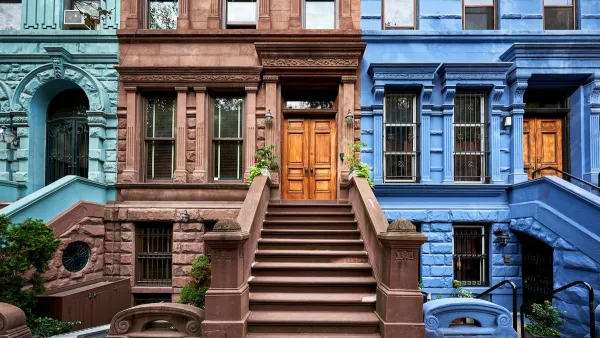Whether kissed by trade winds in Hawaii, home to dozens of unique cultures in the Caribbean, or scoured by Nor’easter’s off the coast of Maine, islands are magnetic to burnt-out urbanites but tend to be tough places for natives. I was a guest not long ago of Fernando Menis, an architect who has built an international reputation from Tenerife, in the Canary Islands. It’s not easy to be true to a unique place – as he aspires to be – when what works locally doesn’t always “translate” in the globalized and image-driven world of architecture.
Whether kissed by trade winds in Hawaii, home to dozens of unique cultures in the Caribbean, or scoured by Nor'easter's off the coast of Maine, islands are magnetic to burnt-out urbanites but tend to be tough places for natives.
I was a guest not long ago of Fernando Menis, an architect who has built an international reputation from Tenerife, in the Canary Islands. It's not easy to be true to a unique place – as he aspires to be – when what works locally doesn't always "translate" in the globalized and image-driven world of architecture.
The Canaries, long settled and for centuries a shipping hub (supplying explorers from Columbus onward) has every island advantage – a unique natural environment, stunning topography, great weather, and beaches – and just about everything wrong with island settlements. Tenerife has the crumbling legacy of high-speed, low-quality 1970s tourist growth, leftovers from "informal" slum building that preceded rapid growth, overburdened infrastructure, an insufficiently diverse economy, and numerous threats to unique natural environments.
Recently Tenerife has tried to put itself on the business and tourist map by erecting postcard-ready important works of architecture, like the self-consciously spectacular and somewhat chilly concert hall by Santiago Calatrava.
By contrast, Menis, like the kinds of "critical regionalists" historian Kenneth Frampton has long championed, tunes his architecture to local materials and craft skills. The Cuchillitos Park, in a beat-up neighborhood of Santa Cruz de Tenerife, may look like a rock sculpture, but the tight budget permitted little elaboration and so he has created an armature, more than a finished work of design. It will blossom into lushness as the exceedingly young plants grow in.
But Menis also applies an architectural inquiry to the tourist landscapes that engulfs much of the coast. Development typically consists of podlike hotel enclaves shrouded in jungly planting or parking. They tend to be poorly connected to the beach and other attractions. They aren't exactly self-contained, but there's hardly more than a sidewalk, let alone any obvious route to shop, sightsee or dine amid the general visual chaos. And the tourist zone developed separate from the older "real" cities, which are appealing, historic, walkable and full of people who live in Tenerife rather than just visit it.
His planning, undertaken annually with students he brings to the island does not try to remake development wholesale. One study threads pedestrian pathways among the developments, taking advantage of the dramatic topography and views. (An amazing amount of the hotel development does neither). Some follow ravines that furrow the landscape, making opportunities to draw the extraordinarily rare and unique landscape into the urbanized resorts. (Queries about future summer Architecture and Urbanism Studios can be directed to [email protected].)
Menis' work shows how locally focused approaches can recognize innate qualities and tease them out in circumstances where replicating the past – the default solution most places – doesn't apply.
Island economies can rarely compete with large-scale mainland cities, but I suspect Menis has understood a way for many of them to carve their own path, becoming successful by becoming more themselves and less like everywhere else.

Planetizen Federal Action Tracker
A weekly monitor of how Trump’s orders and actions are impacting planners and planning in America.

Map: Where Senate Republicans Want to Sell Your Public Lands
For public land advocates, the Senate Republicans’ proposal to sell millions of acres of public land in the West is “the biggest fight of their careers.”

Restaurant Patios Were a Pandemic Win — Why Were They so Hard to Keep?
Social distancing requirements and changes in travel patterns prompted cities to pilot new uses for street and sidewalk space. Then it got complicated.

Platform Pilsner: Vancouver Transit Agency Releases... a Beer?
TransLink will receive a portion of every sale of the four-pack.

Toronto Weighs Cheaper Transit, Parking Hikes for Major Events
Special event rates would take effect during large festivals, sports games and concerts to ‘discourage driving, manage congestion and free up space for transit.”

Berlin to Consider Car-Free Zone Larger Than Manhattan
The area bound by the 22-mile Ringbahn would still allow 12 uses of a private automobile per year per person, and several other exemptions.
Urban Design for Planners 1: Software Tools
This six-course series explores essential urban design concepts using open source software and equips planners with the tools they need to participate fully in the urban design process.
Planning for Universal Design
Learn the tools for implementing Universal Design in planning regulations.
Heyer Gruel & Associates PA
JM Goldson LLC
Custer County Colorado
City of Camden Redevelopment Agency
City of Astoria
Transportation Research & Education Center (TREC) at Portland State University
Camden Redevelopment Agency
City of Claremont
Municipality of Princeton (NJ)






























